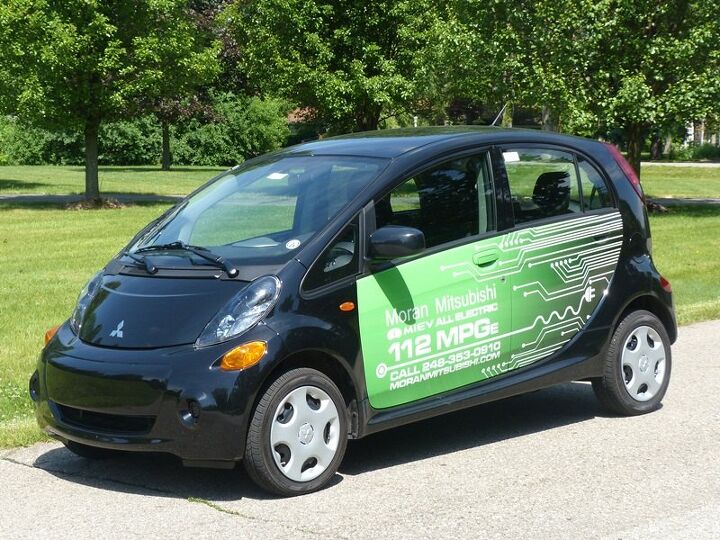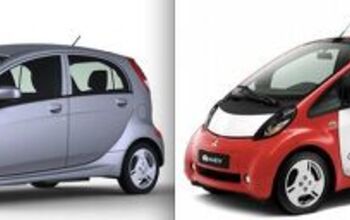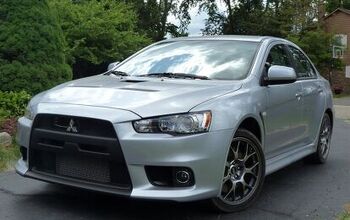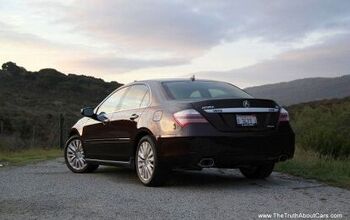Review: 2012 Mitsubishi I-MiEV
A rear-wheel-drive four-door hatchback with staggered wheels and a mere 2,579 pounds distributed 45/55. From the folks who gave us the Evo. Sounds awesome, doesn’t it? But the Mitsubishi i-MiEV (conversationally referred to as either the “i” OR the “meev”) isn’t that sort of car. Its focus is just as narrow as the Evo’s but could hardly be more different: the cheapest, most energy-efficient electric car you can buy in the United States. How cheap? The i-MiEV’s low-20s price (after a $7,500 tax credit) isn’t much higher than that of a Toyota Prius c, the cheapest, most energy-efficient hybrid.
The Prius succeeded in part because it looked like nothing else. Even the most car-ignorant person can readily identify one. The i-MiEV similarly won’t be confused with any other car. Even the wipers are radically different (the one on the right was bent upwards by engineers, not hooligans). But will Americans identify this ultra-compact egg-on-wheels as a car at all? The Prius c is nearly 20 inches less lengthy than the regular Prius. The i-MiEV (despite sharing a 100.4-inch wheelbase) is another foot shorter still (144.7 vs. 157.3 inches). The Mitsubishi is also over four inches narrower (62.4 vs. 66.7 inches) but nearly seven inches taller (63.6 vs. 56.9 inches). This is after being widened a couple of inches for North America. Road-legal cars with four doors don’t get any smaller in North America. Even SUVs are generally wider than they are tall.
Given the price range, it should come as no surprise that nearly every interior surface save the seats is hard plastic in both cars. The i-MiEV’s interior nevertheless manages to seem much more spartan than the Prius c’s.
Hybrids and electric vehicles often provide detailed feedback on your driving style and energy use. The i-MiEV’s instruments are conventionally-located and very basic, just a speedometer, a fuel gauge, a needle that instantaneously provides feedback on the heaviness of your foot when accelerating and braking (lighter is better), and an exterior temp / distance-to-empty readout. Unlike in the Prius c, Volt, or LEAF there’s no way to evaluate your driving style beyond the current moment or track your efficiency over time.
Due to the Mitsubishi’s tall, narrow body, you sit higher than in the typical car but with a bare minimum of shoulder room. The front seats are very close together. The width increase over the JDM car went into an extra inch between your outside shoulder and the B-pillar, and you’re still very close to the latter. The steering wheel neither tilts nor telescopes. The driver’s seat has a height adjuster, but hardly anyone will use it. Even with the seat in its lowest setting the windshield header intrudes on sightlines far more than the instrument panel does (for this driver of middling height). You’ll be well versed in the contents of the airbag warning label. And you’ll want to stop well short of the mark at traffic signals.
Sitting behind myself in the i-MiEV, my shins graze the front seatbacks. The seat is mounted high off the floor, so I’m reasonably comfortable aside from not having an inch of space to spare. Cargo space is similarly minimal, no surprise given the nearly nonexistent rear overhang. Even a B-Segment Prius c seems spacious compared to the A-segment i-MiEV.
Elsewhere you’ll find zero-to-sixty times for the i-MiEV in the 13-to-15 second range. But it doesn’t seem quite that slow because of the smooth, torquey delivery of the 66-horsepower electric motor. As with other hybrids and electrics, glacial acceleration with the digital speedometer incrementing about once a second just feels right. Those in your rear view mirror may not appreciate such leisurely acceleration, and even a Prius c, with its 11-second 0-60 time, would hand the i its rear in a thoroughly pointless drag race.
Ah, but the fuel economy. I wasn’t able to measure the i-MiEV’s efficiency. The EPA (which tends to be conservative on this metric) says it’ll go 62 miles on a charge while getting the gas equivalent of 126 miles-per-gallon city, 99 highway, and 112 combined. Only the upcoming Honda Fit EV does better, 118 combined, and it will be lease-only. The upcoming Focus EV checks in at 105, and the LEAF at 99. At the average electricity price of 12 cents per kWh, the i-MiEV costs about two dollars to recharge. In my driving the Prius c, with EPA ratings of 53 city, 46 highway, and 50 combined, averaged about 62 miles-per-gallon ( additional details and photos here). It might be the most fuel-efficient gas-powered car, but in terms of fuel cost per mile it’s still about double the i-MiEV.
Refueling remains the largest weakness of EVs. Using a standard outlet, it takes 22.5 hours to recharge the i-MiEV. Spend a grand or two to install a Level 2 (240v) home charger, and charge time drops to seven hours. A Level 3 (480v) charge port is a $700 option. You can’t get a Level 3 charger at home, at least not at a remotely reasonable price. But find a public Level 3 station and charging to 80 percent of capacity (the max with a fast charger) takes only about 30 minutes.
Yes, this is a slow car, but slow cars can be fun to drive, especially if they only weigh about 2,500 pounds (i.e. about 500 pounds less than the regular Prius and about 800 less than the Nissan LEAF). The i’s basic specs are promising. But the combination of an undersquare body with a rear-heavy weight distribution (the motor is in back) must have kept Mitsubishi’s engineers up at night. They didn’t stagger the wheels to enable more aggressive turn exits. Instead, they’ve designed the suspension and undersized the grip-resistant front tires (145/65R15 vs. relatively meaty 175/60R15s on the rear) to force the i-MiEV to start scrubbing towards the outside curb well before it might build up enough lateral force to spin out or roll over. In the 70s on the highway (it tops out at 81) the Mitsubishi feels tippy and skittish. It’s well out of its element (that element being the perpetual gridlock of metro Tokyo, where the i-MiEV compares favorably to minicars never offered in North America). A Prius c is a serene highway cruiser in comparison. Around town both cars actually ride fairly well; neither is remotely punishing or overly floaty.
The Prius c One lists for $19,710, the i-MiEV for $22,475 (after a $7,500 tax credit but before a Level 2 home charger). Even with both cars in their base trim, the Prius c has nearly $1,600 in additional content, as calculated by TrueDelta’s car price comparison tool, for a feature-adjusted price difference that exceeds $5,000 once the cost of the home charger is factored in. On top of this, the Prius C performs and handles better, is roomier, and is simply much more like a regular car. You’re spending more and giving up a lot to save perhaps $500 in fuel costs per year.
A problem for both cars: they don’t just compete with each other. For another $4,065 ($2,935 after adjusting for feature differences), you can get the larger and more powerful but nearly as efficient (based on EPA tests) regular Prius instead of a Prius c. For another $6,075 (but only $2,065 after adjusting for feature differences) you can get a Nissan LEAF instead of an i-MiEV. An argument might be made for the Prius c over the regular Prius, as it gets considerably better fuel economy when driven with a feather-light foot and has a more conventional driving position. It’s much harder to justify the i-MiEV over a LEAF, as you must make major sacrifices in just about every area in return for the Mitsubishi’s lower price. If you can afford to spend the extra money, spend it. Or, if you enjoy driving, spend the extra money on gas and get a Ford Focus or Mazda3.
Pat Hennessey of Art Moran Mitsubishi in Southfield, MI, provided the i-MiEV. He can be reached at 248-353-0910.
Toyota provided the Prius c with insurance and a tank of gas.
Michael Karesh operates TrueDelta.com, an online provider of car reliability and real-world fuel economy information.
Michael Karesh lives in West Bloomfield, Michigan, with his wife and three children. In 2003 he received a Ph.D. from the University of Chicago. While in Chicago he worked at the National Opinion Research Center, a leader in the field of survey research. For his doctoral thesis, he spent a year-and-a-half inside an automaker studying how and how well it understood consumers when developing new products. While pursuing the degree he taught consumer behavior and product development at Oakland University. Since 1999, he has contributed auto reviews to Epinions, where he is currently one of two people in charge of the autos section. Since earning the degree he has continued to care for his children (school, gymnastics, tae-kwan-do...) and write reviews for Epinions and, more recently, The Truth About Cars while developing TrueDelta, a vehicle reliability and price comparison site.
More by Michael Karesh
Latest Car Reviews
Read moreLatest Product Reviews
Read moreRecent Comments
- Lou_BC Maybe if I ever buy a new car or CUV
- Lou_BC How about telling China and Mexico, we'll accept 1 EV for every illegal you take off our hands ;)
- Analoggrotto The original Tassos was likely conceived in one of these.
- Lorenzo The unspoken killer is that batteries can't be repaired after a fender-bender and the cars are totaled by insurance companies. Very quickly, insurance premiums will be bigger than the the monthly payment, killing all sales. People will be snapping up all the clunkers Tim Healey can find.
- Lorenzo Massachusetts - with the start/finish line at the tip of Cape Cod.










































Comments
Join the conversation
The local Mitsubishi dealer has a half dozen of them that haven't been touched in two months. I don't see the i-MiEV being the car that keeps Mitsubishi from giving up here. I give Mitsubishi motors two years before they ditch the U.S. & Canada. The i-MiEV is going to be a horrible sales embarrassment. I see a fair number of Leafs, Volts, Prii, and even the odd focus electric here in Pittsburgh. The fact that a fair number of parking garages in downtown Pittsburgh, PA have charging stations.
As golf carts go, this one's killer..